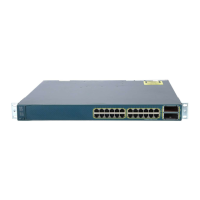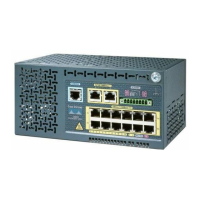14-4
Catalyst 3750 Switch Software Configuration Guide
78-16180-02
Chapter 14 Configuring VTP
Understanding VTP
Note Because trunk ports send and receive VTP advertisements, you must ensure that at least one trunk port
is configured on the switch stack and that this trunk port is connected to the trunk port of another switch.
Otherwise, the switch cannot receive any VTP advertisements. For more information on trunk ports, see
the “Configuring VLAN Trunks” section on page 13-16.
VTP advertisements distribute this global domain information:
• VTP domain name
• VTP configuration revision number
• Update identity and update timestamp
• MD5 digest VLAN configuration, including maximum transmission unit (MTU) size for each
VLAN.
• Frame format
VTP advertisements distribute this VLAN information for each configured VLAN:
• VLAN IDs (ISL and 802.1Q)
• VLAN name
• VLAN type
• VLAN state
• Additional VLAN configuration information specific to the VLAN type
VTP Version 2
If you use VTP in your network, you must decide whether to use Version 1 or Version 2. By default, VTP
operates in Version 1.
VTP Version 2 supports these features that are not supported in Version 1:
• Token Ring support—VTP Version 2 supports Token Ring Bridge Relay Function (TrBRF) and
Token Ring Concentrator Relay Function (TrCRF) VLANs. For more information about Token Ring
VLANs, see the “Configuring Normal-Range VLANs” section on page 13-5.
• Unrecognized Type-Length-Value (TLV) support—A VTP server or client propagates configuration
changes to its other trunks, even for TLVs it is not able to parse. The unrecognized TLV is saved in
NVRAM when the switch is operating in VTP server mode.
• Version-Dependent Transparent Mode—In VTP Version 1, a VTP transparent switch inspects VTP
messages for the domain name and version and forwards a message only if the version and domain
name match. Because VTP Version 2 supports only one domain, it forwards VTP messages in
transparent mode without inspecting the version and domain name.
• Consistency Checks—In VTP Version 2, VLAN consistency checks (such as VLAN names and
values) are performed only when you enter new information through the CLI, the Cluster
Management Software (CMS), or SNMP. Consistency checks are not performed when new
information is obtained from a VTP message or when information is read from NVRAM. If the MD5
digest on a received VTP message is correct, its information is accepted.
